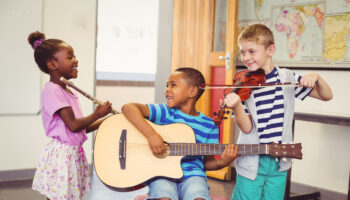by Pam Schaffner
The assessment team in PA is often asked if they have any tips to make meeting quality standards easier. Since they have experiences visiting many programs in their professional careers, they have seen many programs employ strategies to make things easier, more efficient, and more effective. Implementing quality can be stressful or time consuming, but always worth it. So, this Q-T Corner moment aims at helping you along the way.
Four things to consider when planning and conducting circle time. C.A.V.E.
C: Content
A: Active participation
V: Variety
E: Excitement
C for Content: What do I want to teach? Why do young children need to learn this concept at this point in their life?
When planning, it is important to think about why you are teaching a particular idea. Our primary goal as teachers is to help children learn and develop skills they need to reach the next stage of development. Does what I want to teach accomplish this end, or is it something that is not applicable at this time? For example, do you see value in preschoolers knowing all the Presidents of the United States in order? Is it important that preschoolers know characteristics of the planets prior to understanding things they see and experience in their own world?
When deciding on a topic (the content), ask if it is relevant to the life experiences of the children and if that content is too abstract, difficult, or boring for the children. For example, one common activity chosen for circle time is the calendar. The concept of time is abstract because it cannot be touched or seen. At what age can children understand such concepts? Research suggests that although preschool children can understand timing concepts such as “later,” “before,” and “after,” more complex concepts such as understanding a week or a month in terms of timing is less understood. Have you ever asked your group to tell you what month it is, and they say 2022? They do not understand the concept, and thus, there is little to no value in teaching it before they are ready to understand it. See the following article for more information: https://www.naeyc.org/sites/default/files/globally-shared/downloads/PDFs/resources/pubs/calendartime.pdf
A for Active participation: Can the children be active in the lesson? Are they just sitting and listening, or can they respond? Can they move their bodies during the lesson? Does my lesson keep everyone engaged at the same time or is the pacing slow and children must wait for a turn?
Children do not sit still very well. Neither do adults. Have you tried to sit on the floor with your legs crossed for 20 minutes sitting up straight? I guarantee if you try it you will resort to a new posture very quickly: one of comfort. It is not realistic to expect children to listen and learn if they are not comfortable first. Invite children to sit as they wish, lay down, bring a chair or pillow to your whole group time. Their attention span will be longer if they are not thinking about making sure to sit in the posture you asked of them.
Engage as many of their senses as you can to promote the greatest opportunity for learning. For example, imagine explaining how magnets work to children using only your voice without showing them any magnets. Now imagine how much better they can understand if you show them how magnets work using both your voice (so they can hear) and some magnets (so they can see the magnets work). Now imagine going one step further. Let the children use the magnets. Now you have them engaged with hearing you talk (hearing), seeing the magnets work (seeing), and touching them so they can feel the magnetic pull (touch/hands-on learning). They will learn most when they can engage as many senses as possible and will likely stay active in the lesson.
Keep all children active at once. Using the magnet example above, let’s think about how to keep children actively engaged in the lesson. What happens if you have 20 children in circle time and one set of magnets to pass around? One child is active, and 19 are passive and waiting for a turn. This will lead to some behavioral issues. Why? Children do not sit and wait very well. If each child had 30 seconds to explore the magnets, that is not enough time, yet even with just a 30 second turn, the last child is waiting for almost 10 minutes with nothing to do. When they are waiting, they are bored. To make the most of the lesson on magnets, the more magnets the better. Have children work with them in small groups, for example.
V is for variety. Is there something new and exciting to every circle time activity? Or is it repetitive and done the same day after day?
As they say, variety is the spice of life. Do you like pizza? Or chocolate cake? I guarantee that after many meals of pizza for breakfast, lunch, and dinner, you will soon have a distaste for pizza. You will crave something new. If your circle time consists of the same sequence of events such as a good morning song, a review of colors from flash cards, and doing the calendar day after day, the children will desire something new. First of all, once they learn a concept such as the colors, a review of them Monday through Friday for 52 weeks will not teach them something new. Nor will it be fun and exciting.
If you want children to come to a large group gathering, you must provide variety; provide something exciting. Give them a reason to want to see what you have planned each day.
E is for Excitement. Are children excited to come to circle time? Have you planned something so wonderful that it piques their interest more than the toys around the room they want to use?
You probably have heard the expression FOMO or Fear of Missing Out. When we experience FOMO we often can ignore promptings within ourselves to ignore other urges. It is why we stop at the restroom before entering a movie theatre or a concert hall. We don’t want to have to use the restroom and then ask, “What did I miss?” Have you ever stayed awake long after you wanted because you just “needed” to see how something concluded?
If you really think about planning exciting things for the children to learn and explore during a large group gathering, they will be excited to join you and will be on the edge of their seat watching and listening to what you have prepared.




